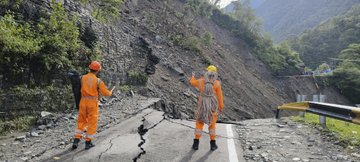PrashantNews
Ashok Kumar, the then Uttarakhand Director General of Police (DGP) travelled extensively in the disaster-hit Kumaon region in 2021 to oversee rescue operations after the floods. He gave a vital piece of information to the media which was very relevant for the future disasters.
Kumar said a catastrophe was averted by the timely evacuation of the people from flood-ravaged areas. “We evacuated nearly 48,000 people from various flood-hit areas. Of them, nearly 50 per cent were living close to rivers and nullahs in spate,” Kumar said.
According to a report prepared by the state police, the devastation could be minimised due to the timely alert the Met gives.
But in normal circumstances as and when an ecological catastrophe strikes, it usually gives very little time to the authorities to act. In case of many disasters like Kedarnath deluge, Rishiganga floods, the Mana avalanche, the disasters came with rattling speeds leaving a trail of death and destruction. The government came to know about the full scale of the Kedarnath tragedy only after two days.
The mana blizzard has also raised several pertinent questions. What was the urgency in carrying out road works when the avalanche-like conditions were persisting in the area? Was the place where the containers stationed, quite vulnerable to the avalanches in the past? Labourers were sleeping inside these eight containers when the avalanche struck. It is also still not known whether these containers were safe in all aspects?
The questions are many but the answers are none. Two days after the Army-led search operation ended at Mana, the government is getting back to basics.
The murmuring from the opposition side on the issue has also stopped. Will there be any inquiry? Who will fix the responsibility, if any? It appears that nobody wants to know.
All these questions are coming up because most of the Himalayan belt is highly fragile. In fact, these mountains are geologically very new. The entire Himalayan area is often considered highly prone to natural disasters. Earthquakes, floods, cloudbursts, landslides, forest fires and avalanches occur frequently in these areas. Scores of lives are lost in these disasters every year. Geologists also claim that many faults in these areas can bring earthquakes as big as 8 on the Richter scale. In the past one month, many earthquakes have rattled many areas in the Himalayan region.
According to a study, the frequency of the natural disasters has increased after the formation of Uttarakhand apparently due to rampant felling of trees construction and widening of new and old roads. Some hydro-projects are also being held responsible for these disasters.
The Chardham yatra is again starting from April 30 this season. And again a big rush of pilgrims will throng Kedarnath and other shrines nestled in the Garhwal Himalayas. Environmentalists have repeatedly cautioned the government against the overcrowding of these pilgrim centres saying the number of pilgrims should not go beyond the carrying capacity of the four religious centres. A report in this regard is still awaited.
The disasters are not striking in Uttarkahand alone. Floods, forest fires and mudslides are occurring regularly in Europe and US. Tens of thousands of people demonstrated in Spain last year over regional authorities’ handling of devastating floods that killed scores of people in one of Europe’s worst natural disasters for decades. In India, no such protests usually occur. This is at least a big relief for governments at the centre as well as in states.

